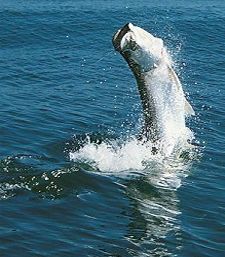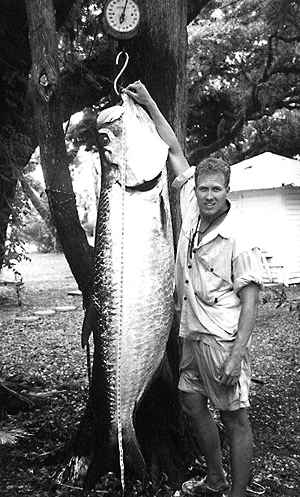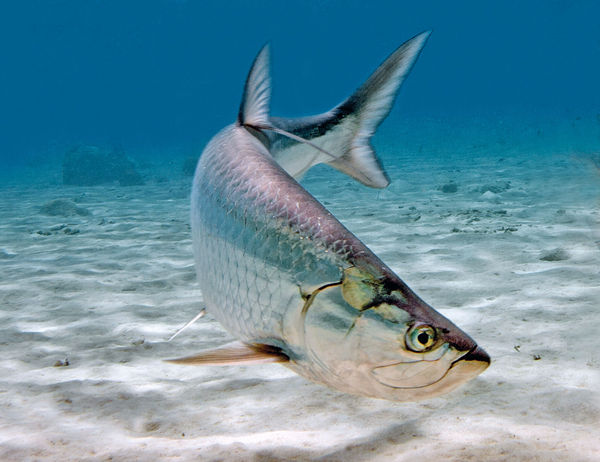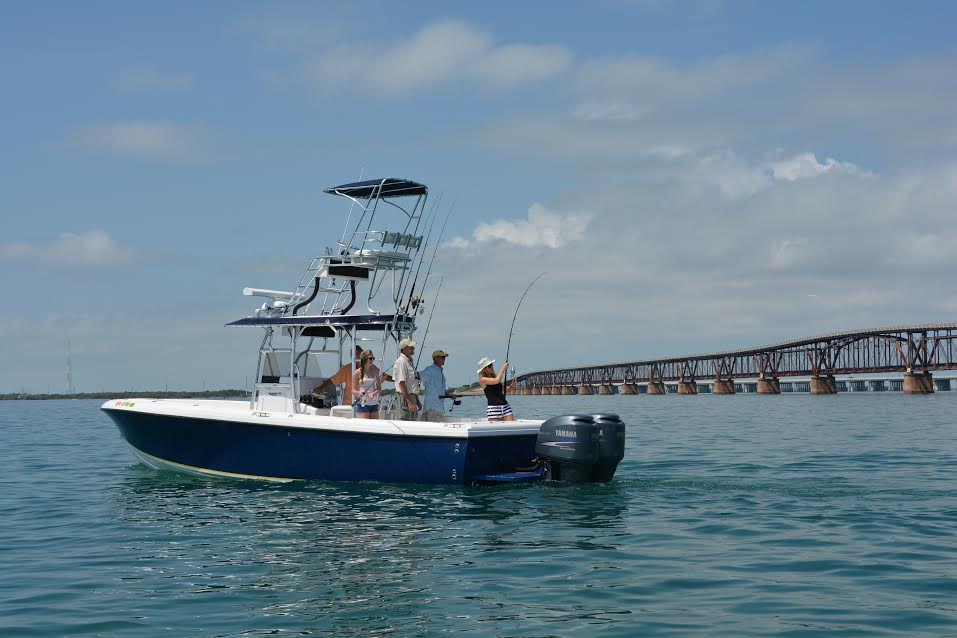Tarpon fishing tips
"The worlds
premier saltwater game fish"
____________________________________
Tarpon are prehistoric sea creatures dating
back 125 million years.
Tarpon fishing with light tackle is considered the ultimate inshore sport fishing experience.
Our tarpon guides practice catch and release
32 years of professional tarpon fishing experience
The life and habits of tarpon
tarpon [tär'pon]
Tarpon , the common name for members of the family Elopidae, large herring like game fish of the warm seas of the Western Hemisphere, tarpon range occasionally from Long Island to Brazil and to the west coast of Africa and enter freshwater streams freely. The tarpons heavy, silvery scales, sometimes used as ornaments, give them the name silver king. Tarpon average 6 ft in length and 150 LB in weight and are about 15 to 30 years old, although some big females may be over 8 ft long and weigh more than 300 LB and be over 50 years old. Tarpon are active and predacious, they prey on schools of small fish and crustaceans. They are favorites of saltwater fishermen, particularly Tarpon Atlanticu's, found in the warmer parts of the Atlantic Ocean. Tarpon are classified in the phylum Chordata, subphylum Vertebrata, class Osteichthyes, order Clupeiformes, family Elopidae.
Megalops Atlanticus, the tarpon. Not a lot is known about tarpon. They have no food value and are generally considered a catch and release sport fish. Tarpon are thought to be prehistoric sea creatures dating back about 125 million years. Tarpon have a unique air bladder that allows them to actually take in air from the surface. The tarpons air bladder helps baby tarpon survive in freshwater and oxygen depleted waters which are free from predators. Tarpon spawn in the spring. A fertilized female may drop as many as 15 million eggs which develop into tiny leech or ribbon like larvae. These larvae migrate from offshore, where they are believed to be born, to inshore estuaries where they develop into tiny tarpon. These tiny tarpon are said to be able to live in some unbelievably fragile water just inches deep. As the baby tarpon grow they continue to move to larger bodies of water until they reach sexual maturity at about 6 to 7 years of age when they join the mature schools of tarpon.
Except for their first 10 years tarpon spend most of their lives offshore and are a bit of a mystery. Tarpon feed primarily on fish and crustaceans. During the spring spawn tarpon collect inshore by the thousands offering anglers an incredible fishing opportunity. The largest tarpon are thought to weigh up to 300 pounds but really big Florida tarpon weigh around the 200 pound mark. The Florida state record tarpon weighed 243 pounds, caught by Gus Bell in the Florida keys. Our fishery produces lots of tarpon from 80 to 150 pounds and a good number of 200 pound fish. In our area of the Florida Keys there are always smaller resident tarpon available to the angler year round. The best Florida Keys tarpon fishing is from March through June with the peak migration occurring from April through May.
Dead or alive? "It's in your hands"
Live bait tarpon fishing
We specialize in live bait tarpon fishing and use crabs, shrimp, pinfish and mullet. The basic live bait technique is to anchor our boat and free line a lively bait down current to areas we know hold tarpon. Sometimes the bait is weighted to get it near the bottom. Weights very with the speed of the tidal current. Heavy weights can cause hooks to pull out. To correct this we use light copper wire to attach the weights to our line so they will easily drop off and not be a hazard when we fight the tarpon. Sometimes a small piece of Styrofoam is rigged as a breakaway float to suspend the bait. We will also use slip bobbers and small ballons with split shot to drift crabs down current. Tarpon are powerful and have hard rough mouths, sharp gill plates, and abrasive scales. For tarpon fishing leaders we use about 6 to 12 feet of heavy monofiliment or fluorocarbon line from 50 to 80 LB test. Tarpon fishing hooks will vary with the size of the bait and hook brand. A 4/0 to an 11/0 circle hook is what we like best. It's important to rig the live baits in the most natural way possible. For tarpon fishing with live bait you should hook a crab in the corner of the shell, pinfish and mullet are hooked through the mouth either vertically or horizontally. When you are fishing with shrimp a good trick is to head or tail hook the shrimp on a jig so it won't spin in the current. In the old days and even today some guides only take a dozen mullet for bait on a tarpon fishing charter. We catch lots of tarpon on crabs and pinfish. We like to have plenty of choices because tarpon are difficult fish to catch. Some days tarpon will only eat small pinfish and other days tarpon eat only crabs. The speed of the tidal current plays a big part in tarpon fishing success. When the current is running fast a mullet will be the best choice for a bait because it won't spin as much in the current. An experienced tarpon guide will use various sizes and types of bait for the conditions. As you can see there are lots of variables to consider as well as other fish to catch while you're fishing for tarpon. When we are tarpon fishing we like to keep a bait on the bottom and one or two baits free lined at different depths. For the best results we will use 3 or 4 different baits at the same time until we find what the tarpon prefer. If the tarpon don't bite change your bait, change your rigging, change your leader or change the depth you are fishing. If that doesn't work move to a new location.Tarpon fishing with artificial baits
Although we specialize in live bait tarpon fishing we have had good luck with big top water baits and minnow imitations as well as soft plastic baits. For top water tarpon fishing casting big chuggers and sliders like the Zara Spook can be productive. For chuggers and poppers we like to use a "chug and pause" presentation. For sliders you can't beat "walking the dog". You can fish big minnow baits with a fast retrive and add a pause or stall to make the retrive more erratic. It is always a good idea to try different speeds of retrive depending on current conditions. Some of the best artificial baits for tarpon fishing are big soft plastics that immitate bait fish, eels and sea worms. These can be weighted to fish deep and are versital substitutes for live bait. We fish these baits slow and like to free line, dead drift them deep or rig them on jigs just like live bait. Casting across the current can also be effective.
Tarpon fishing rods and line
We like light tackle for tarpon fishing. For fishing bridges 20 LB spinning gear or 30 LB conventional gear is required. For open water tarpon fishing and smaller tarpon you could drop down to 12 or 15 LB tackle depending on the size of the tarpon. We have found Ande or Trileen Big Game monofilimant line to be good choices for cost and performance. Mamoi Hi-Catch or Diamond Premium is more expensive and is a good line as well as good leader material. You should also have some Florocarbon leader for the tough bite. We also use braided line and like Power Pro 50 pound. Our conventional reel of choice would be a Shimano TLD20. Penn, Shimano, Diawa and Fin-nor all make good 20 LB spinning reels for tarpon fishing. Shimano, Diawa and Penn make decent rods. Ugly Stick and Star hand crafted rods are solid performers. For a little more money there are some really nice custom rods available. We like a 7 foot rod. It is a good idea to use a gimbaled rod of a heavier weight than your line rating and be sure to have a fighting belt!Tarpon fishing tips
1. Setting the hook. Most live bait tarpon fishing in Florida will be done with circle hooks. You don't need to set the hook hard with tarpon. Because of the tarpon's hard mouth the best approach is to drop back about 10 feet of line and let the line tighten up or, for the inexperienced, just leave the rod in the rod holder until the tarpon is stripping line off your reel. Another trick is to put the rod tip in the water and reel fast! All of these tarpon hook setting techniques allow the hook to hit one of the three soft spots in a tarpons mouth, the corners on either side or the button in the middle.
2. Set the drag right. Many anglers set the drag to tight for tarpon fishing. 20% to 25% of the line weight is a good rule. Remember knots weaken your line up to 25%. If you are tarpon fishing with 20 pound test line set the drag at 4 to 5 pounds. A good way to be sure of the drag setting is to use a hand held scale to double check your setting. If the tarpon keep breaking your line use heavier line! Maintain your drag and keep your drag washers clean, to keep a drag running smoothly try lubricating the washers with a little STP. Bridge fishing has its own rules and requires the most drag and maximum pressure.
3. Let the tarpon run. Tarpon are strong and usually give you a very hard initial run. When tarpon fishing often lines are broken starting the drag. If you are fishing in open water let the tarpon run until it looses some steam then apply pressure. If you are fishing around obstacles that might cut your line use heavier line and tackle, put more pressure on the tarpon and chase the tarpon with your boat.
4. Good knots. Learn how to tie the best knots for tarpon fishing. To tie a hook or swivel on to monofiliment line up to about 50 LBS a palomer knot is hard to beat and lots of anglers like a loop knot. For heavier mono try an clinch knot or uni-knot. For joining heavy leader to the main line a surgeons knot is my favorite but a well tied blood knot or a uni-knot work. Be sure you pull your knots up tight!
5. Proper leaders. A tarpons body and gill plates are abrasive and can damage line in hurry. A light leader set up for tarpon fishing would be 5 feet of 50 LB fluorocarbon leader attached to 15 or 20 LB doubled main line. For bridge tarpon fishing try 6 to 10 feet of 60 to 80 LB leader tied directly to 50 LB braid main line. If you use lead weights be sure to attach them with light copper rigging wire so they will drop off before the fight, they can be like bullets when a tarpon throws the hook.
6. Fight a tarpon right. If you are tarpon fishing in open water and you hook up with a tarpon be ready for a strong run and some jumps. This is not the time to apply a lot of pressure. After the initial frantic run start to apply pressure. The rod is for fighting the tarpon, the reel is for storing the line. Try to avoid fighting the tarpon with the rod high over your head. Keep steady pressure on the tarpon by holding your rod tip down and pump up, reel down, pump up and reel down. Use the rod to pull the tarpon to you without reeling, use the reel to pick up the line you have pulled to you by dropping the rod toward the tarpon and reeling fast. When the tarpon jumps let off pressure or "bow to the king", this keeps the line from being cut on the tarpons gill plates and body. If you feel a strong run point the rod tip at the fish and let it run on the drag resuming pressure as the run slows. When you feel the pressure let off pick up the slack by reeling fast until you can put the pressure back on. It's always best to fight a tarpon as close as you can without getting to much line out. This will reduce the chances of getting cut off and makes it much easier to control a tarpon. The most common mistake anglers make is not being alert and prepared for the power these fish have. Trust your drag and put plenty of pressure on these big fish.
7. Bridge tricks for fighting a tarpon. Tarpon love current and bridge passes. Tarpon fishing at bridges is a situation requiring the best skill and experience. Many tarpon have been cut off on the concrete pilings. This is where an experienced tarpon fishing guide can really help. Boat control and the ability to chase a tarpon are key elements. When tarpon fishing we usually anchor up current of the bridge pilings and let our baits drift back to the tarpon. We use a quick release line and a float to hold the anchor line, when you hook up with a tarpon quickly release your anchor and chase the tarpon. If you're lucky the tarpon will swim away from the bridge and into open water where you can enjoy the fight. If the tarpon stays in the the pilings good luck! We usually give chase, try to get down tide, apply a lot of pressure and try to shorten up the line as much as possible. If it's not a big tarpon you can pull it out of the pilings. You must work quickly as a team with the angler aggressively getting the tarpon under control and the boat operator watching the line and positioning the boat to keep the line clear of the bridge pilings. You can either pull the tarpon out or get cut off so put the pressure on. Once you clear the bridge try to position your boat between the bridge and the tarpon. Tarpon will usually swim away from the direction of pressure. Tarpon are big strong fish and you must trust your tackle and drag to overpower them.
8. Keep the tarpon's head up. When you get the tarpon close to the boat keep the tarpon's head up so it won't start another run. During the fight when you are gaining line keep it up. Pump hard and fast to control the fish. Learn what pressure is to a 100 LB tarpon and keep the pressure on!
9. Catch and release tips. We take the greatest care with these beautiful prehistoric sea creatures. These incredible fish were made for angling and we should do everything possible to preserve our tarpon fishery for the generations to come. For live bait tarpon fishing circle hooks are the best for releasing tarpon unharmed. Don't let the tarpon run too long with the live bait before setting the hook and try not to fight a tarpon so long that it becomes exhausted. Release tarpon at the side of the boat without lifting them out of the water. Lifting a tarpon or bringing a tarpon aboard for a photograph will kill it. Wear gloves to leader and handle a tarpon. You can leave the tarpon in the water and grab the lower jaw with a gloved hand to remove a hook. If you can't remove the hook cut the leader as short as possible, the salt water will dissolve the hook. Sharks kill a lot of tarpon and usually attack when the tarpon is tired. Learn how much pressure you can apply and land them as quickly as possible. Better yet...enjoy the challenge of hooking up and the thrill of the jump and don't even consider landing them.Jump a tarpon and let 'um go!
Our roomy BLUEWATER 2850 chasing down a tarpon at the Bahia Honda Bridge



